Abstract
STUDY OBJECTIVES: To describe and discuss the methods used to recruit and maintain an unbiased sample of older discharged hospital patients in a study of the process and outcomes of hospital care. DESIGN: Prospective longitudinal interview study of consecutive patients admitted to hospital over a 12 month period and followed up for six months. Interviews took place in hospital five days after admission, at home 10 days after discharge, and six months after admission. SETTING: Six hospital locations: three in the north of England and three in the south. PARTICIPANTS: People aged 65 and over admitted to hospital with a new stroke or fractured neck of femur, their significant other, and nursing staff caring for them. MAIN RESULTS: Of 3105 patients referred to the study, 2111 were eligible and 1671 (79%) were recruited. Recruited stroke patients were younger than those not recruited and rates differed between locations for both stroke and fractured neck of femur. By six months after admission 25% had died. Outcome data were obtained for 85% of the surviving patients. Patients who died were older and frailer before admission. Among survivors, outcome data for stroke patients were less likely to be obtained for men, those more able initially, and those who were married. Response rates to each interview differed according to respondent types. Interviews were more likely to be obtained with significant others than patients. Patients who were not able to be interviewed were older and frailer; significant others were less likely to be interviewed if the patients were younger and more able. CONCLUSIONS: High response rates can be achieved with very frail older people if strategies are adopted to maintain their interest and if self reported data are supplemented by interviewing significant others.
Full text
PDF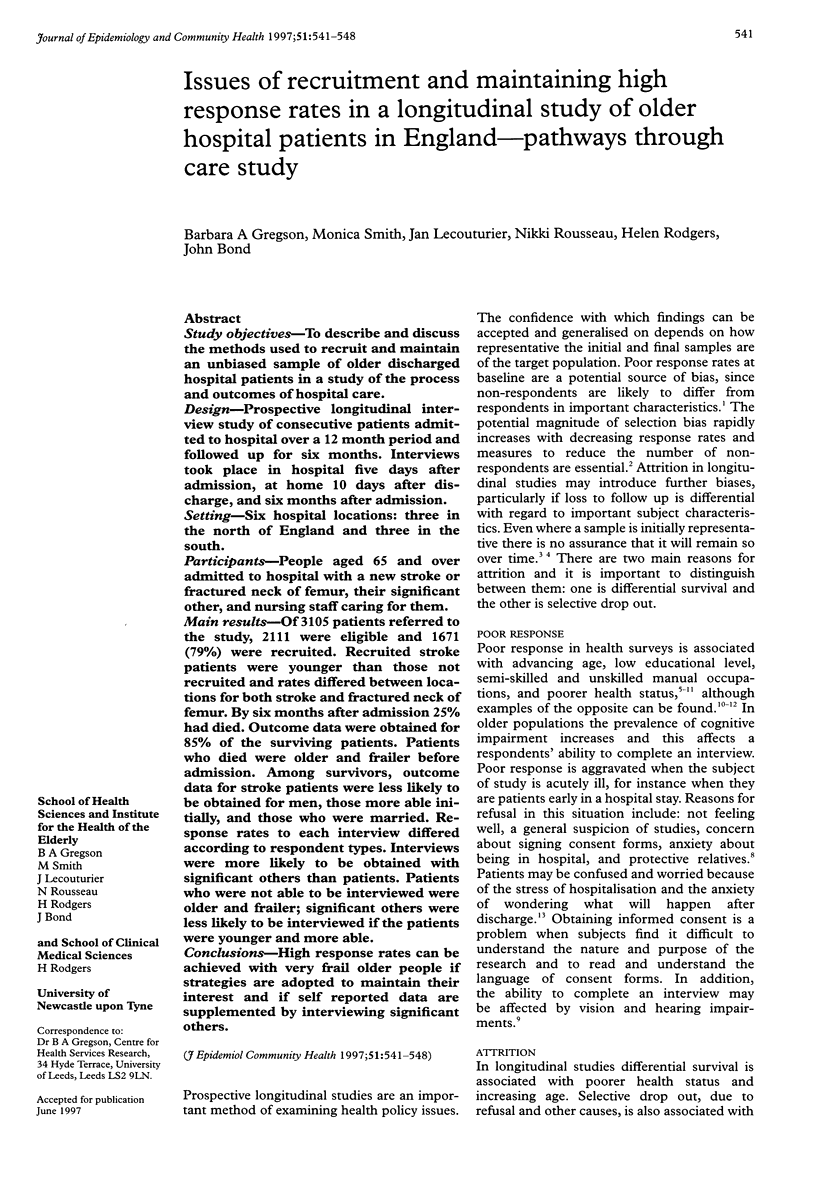
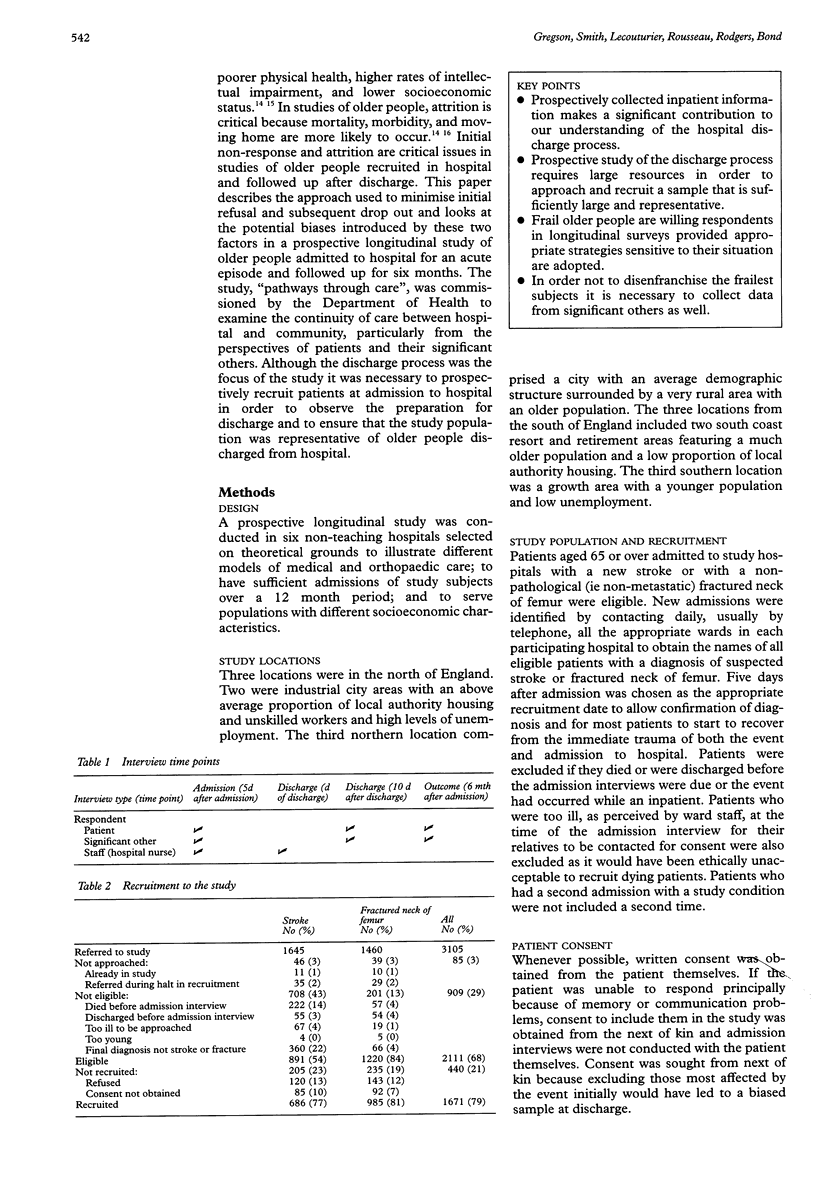
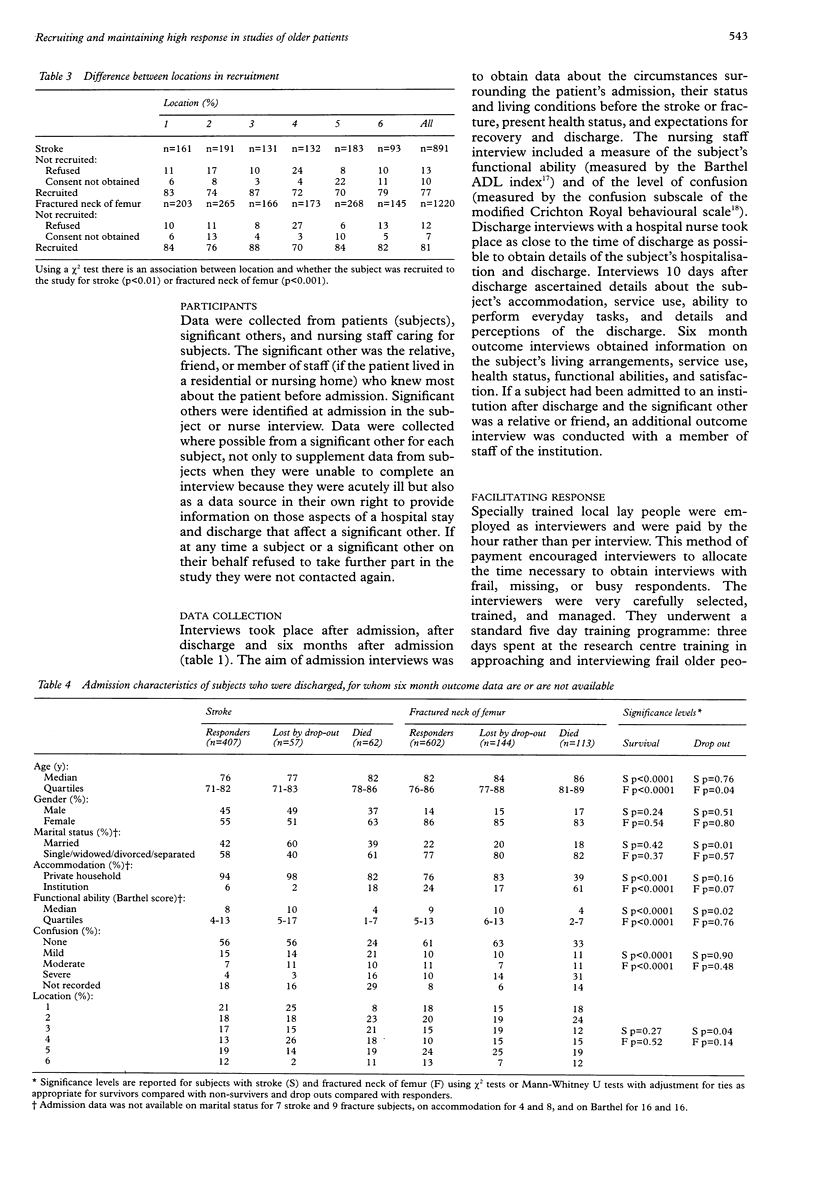
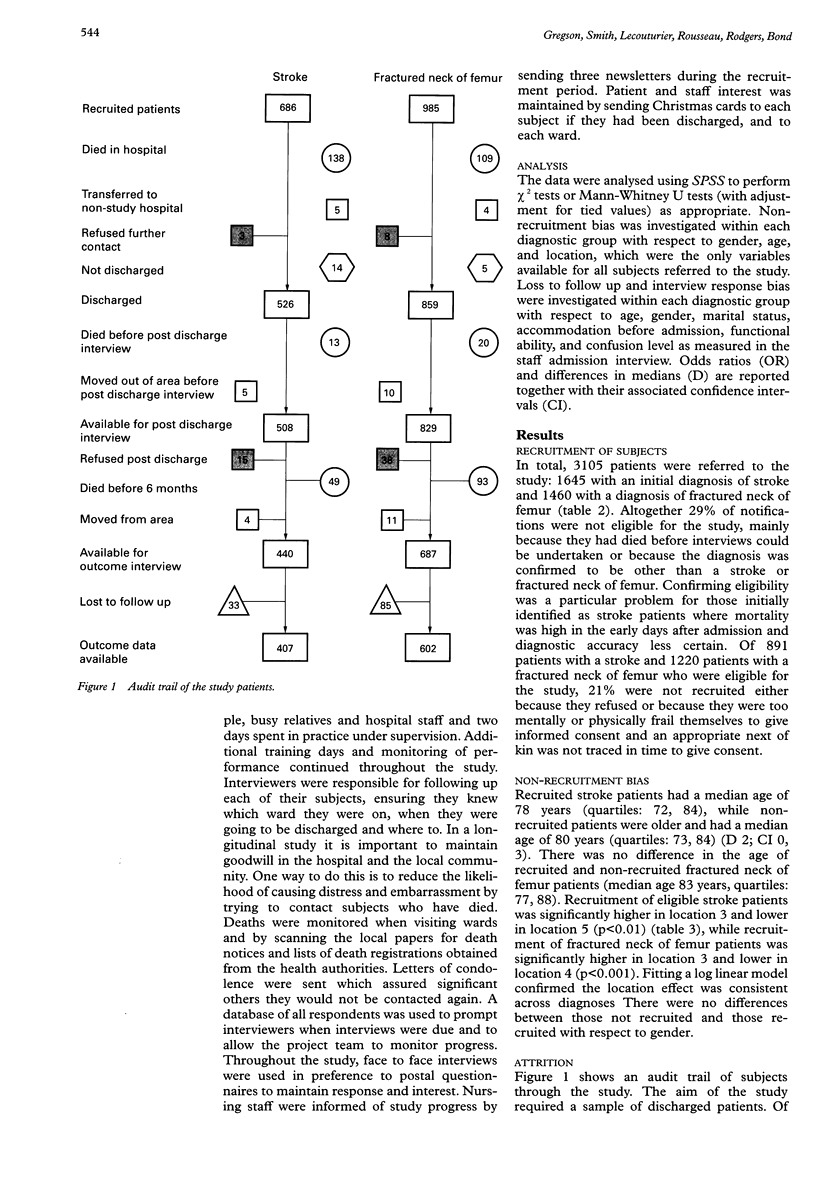
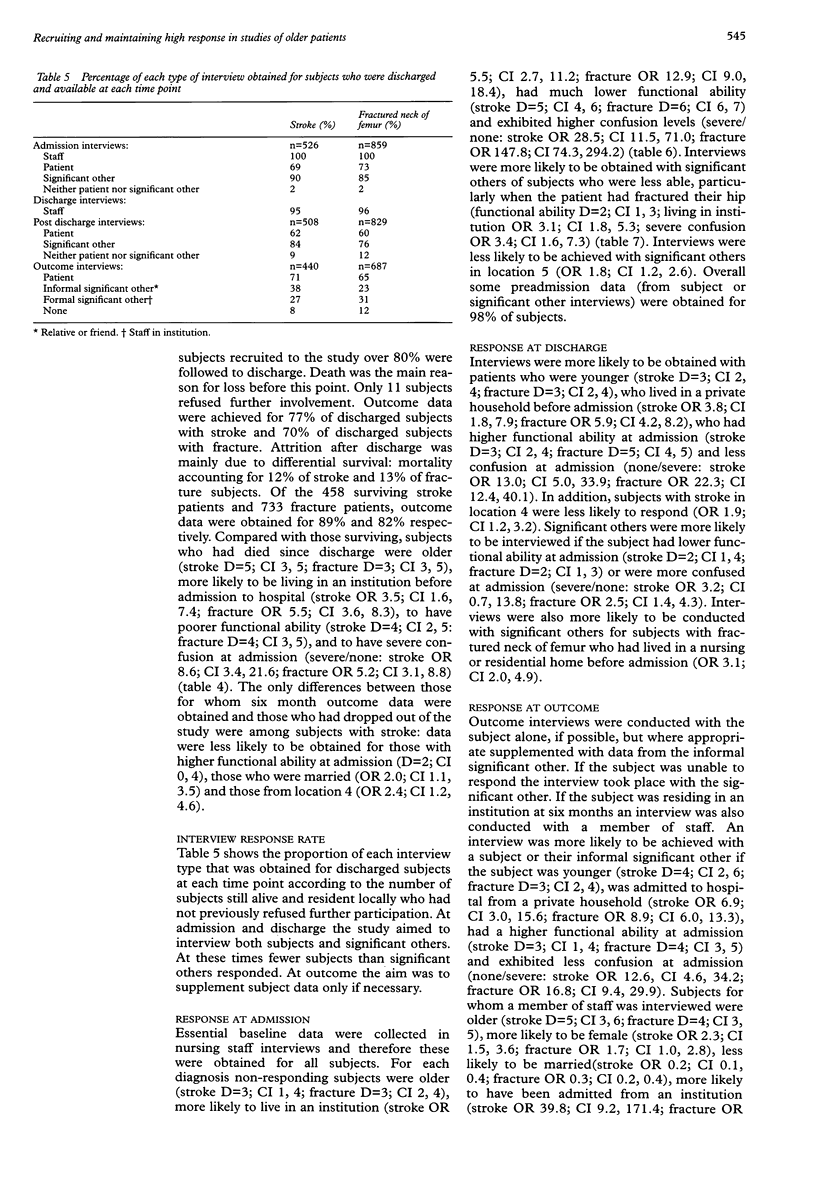
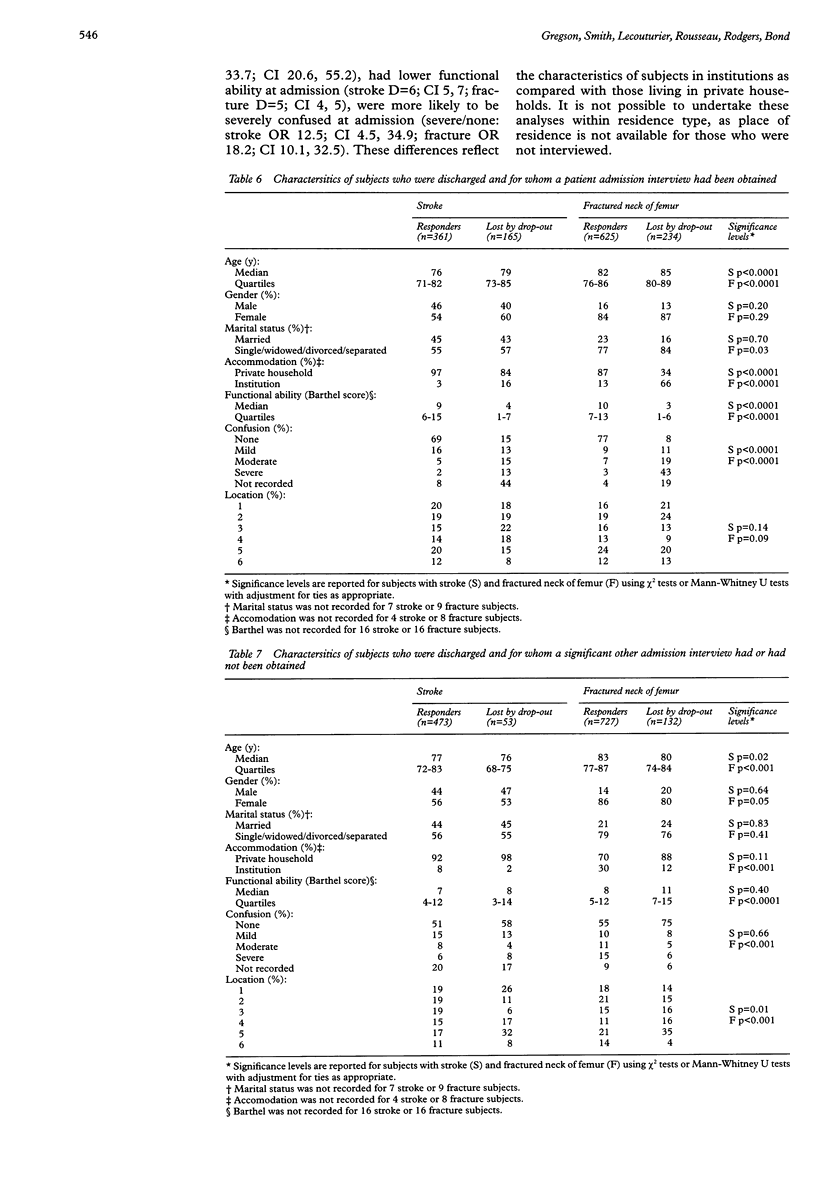
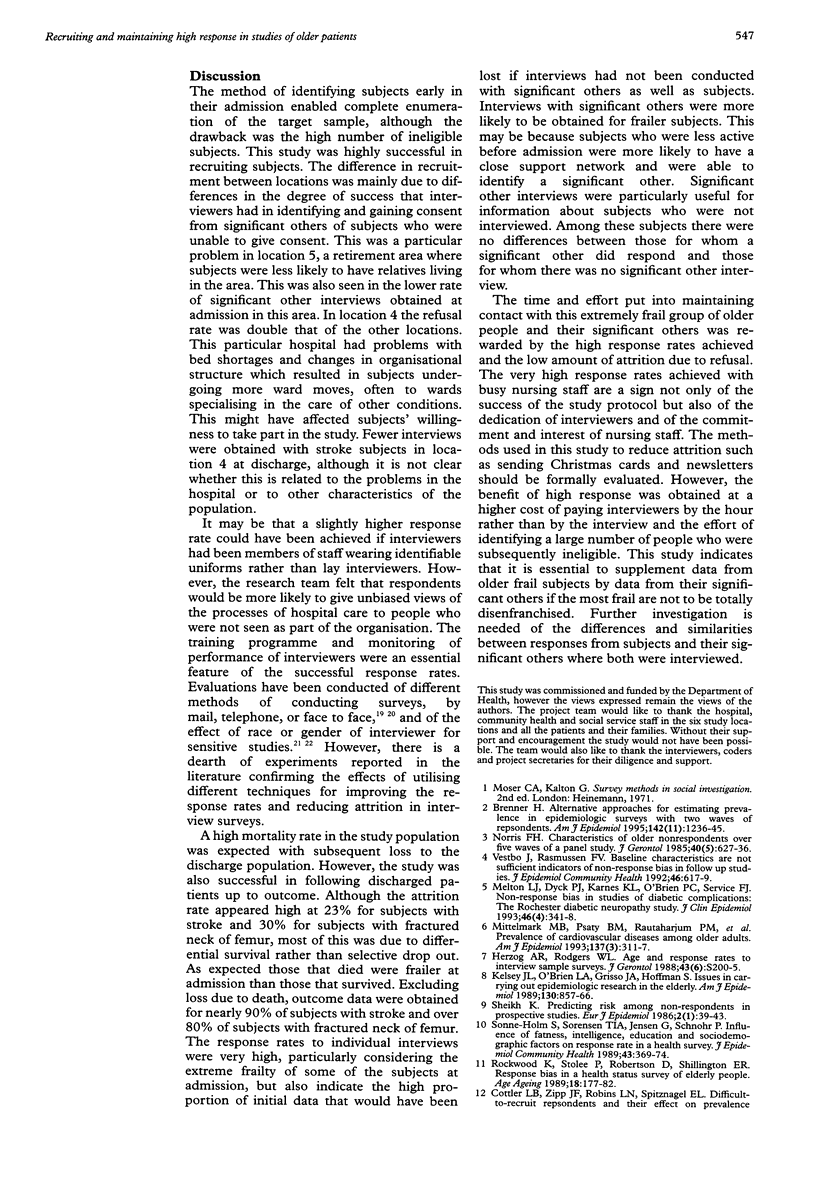

Selected References
These references are in PubMed. This may not be the complete list of references from this article.
- Billig N., Ahmed S. W., Kenmore P., Amaral D., Shakhashiri M. Z. Assessment of depression and cognitive impairment after hip fracture. J Am Geriatr Soc. 1986 Jul;34(7):499–503. doi: 10.1111/j.1532-5415.1986.tb04240.x. [DOI] [PubMed] [Google Scholar]
- Bisgard K. M., Folsom A. R., Hong C. P., Sellers T. A. Mortality and cancer rates in nonrespondents to a prospective study of older women: 5-year follow-up. Am J Epidemiol. 1994 May 15;139(10):990–1000. doi: 10.1093/oxfordjournals.aje.a116948. [DOI] [PubMed] [Google Scholar]
- Brenner H. Alternative approaches for estimating prevalence in epidemiologic surveys with two waves of respondents. Am J Epidemiol. 1995 Dec 1;142(11):1236–1245. doi: 10.1093/oxfordjournals.aje.a117583. [DOI] [PubMed] [Google Scholar]
- Cottler L. B., Zipp J. F., Robins L. N., Spitznagel E. L. Difficult-to-recruit respondents and their effect on prevalence estimates in an epidemiologic survey. Am J Epidemiol. 1987 Feb;125(2):329–339. doi: 10.1093/oxfordjournals.aje.a114534. [DOI] [PubMed] [Google Scholar]
- Herzog A. R., Rodgers W. L. Age and response rates to interview sample surveys. J Gerontol. 1988 Nov;43(6):S200–S205. doi: 10.1093/geronj/43.6.s200. [DOI] [PubMed] [Google Scholar]
- Kelsey J. L., O'Brien L. A., Grisso J. A., Hoffman S. Issues in carrying out epidemiologic research in the elderly. Am J Epidemiol. 1989 Nov;130(5):857–866. doi: 10.1093/oxfordjournals.aje.a115418. [DOI] [PubMed] [Google Scholar]
- MAHONEY F. I., BARTHEL D. W. FUNCTIONAL EVALUATION: THE BARTHEL INDEX. Md State Med J. 1965 Feb;14:61–65. [PubMed] [Google Scholar]
- Melton L. J., 3rd, Dyck P. J., Karnes J. L., O'Brien P. C., Service F. J. Non-response bias in studies of diabetic complications: the Rochester Diabetic Neuropathy Study. J Clin Epidemiol. 1993 Apr;46(4):341–348. doi: 10.1016/0895-4356(93)90148-t. [DOI] [PubMed] [Google Scholar]
- Mittelmark M. B., Psaty B. M., Rautaharju P. M., Fried L. P., Borhani N. O., Tracy R. P., Gardin J. M., O'Leary D. H. Prevalence of cardiovascular diseases among older adults. The Cardiovascular Health Study. Am J Epidemiol. 1993 Feb 1;137(3):311–317. doi: 10.1093/oxfordjournals.aje.a116678. [DOI] [PubMed] [Google Scholar]
- Norris F. H. Characteristics of older nonrespondents over five waves of a panel study. J Gerontol. 1985 Sep;40(5):627–636. doi: 10.1093/geronj/40.5.627. [DOI] [PubMed] [Google Scholar]
- Payne B. J., Ford J. C., Locker D. Loss to follow-up in a longitudinal oral health survey of older adults. Community Dent Oral Epidemiol. 1995 Oct;23(5):297–302. doi: 10.1111/j.1600-0528.1995.tb00252.x. [DOI] [PubMed] [Google Scholar]
- Rockwood K., Stolee P., Robertson D., Shillington E. R. Response bias in a health status survey of elderly people. Age Ageing. 1989 May;18(3):177–182. doi: 10.1093/ageing/18.3.177. [DOI] [PubMed] [Google Scholar]
- Sheikh K. Predicting risk among non-respondents in prospective studies. Eur J Epidemiol. 1986 Mar;2(1):39–43. doi: 10.1007/BF00152716. [DOI] [PubMed] [Google Scholar]
- Sonne-Holm S., Sørensen T. I., Jensen G., Schnohr P. Influence of fatness, intelligence, education and sociodemographic factors on response rate in a health survey. J Epidemiol Community Health. 1989 Dec;43(4):369–374. doi: 10.1136/jech.43.4.369. [DOI] [PMC free article] [PubMed] [Google Scholar]
- Vestbo J., Rasmussen F. V. Baseline characteristics are not sufficient indicators of non-response bias follow up studies. J Epidemiol Community Health. 1992 Dec;46(6):617–619. doi: 10.1136/jech.46.6.617. [DOI] [PMC free article] [PubMed] [Google Scholar]
- Weinberger M., Nagle B., Hanlon J. T., Samsa G. P., Schmader K., Landsman P. B., Uttech K. M., Cowper P. A., Cohen H. J., Feussner J. R. Assessing health-related quality of life in elderly outpatients: telephone versus face-to-face administration. J Am Geriatr Soc. 1994 Dec;42(12):1295–1299. doi: 10.1111/j.1532-5415.1994.tb06515.x. [DOI] [PubMed] [Google Scholar]


